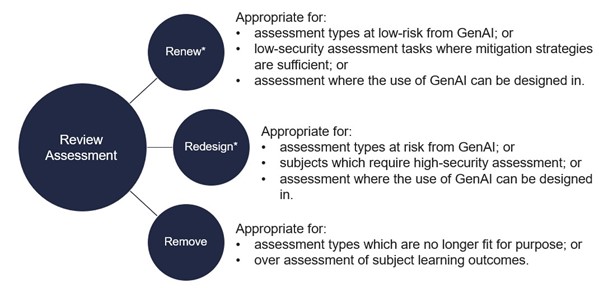Assessment designs can mitigate the risks of GenAI by incorporating high-security elements that validate learning outcomes and teaching students to use GenAI critically in accordance with educational and professional standards.
Some types of assessment are more vulnerable to GenAI. However, at-risk assessment types do not necessarily need to be removed from subjects, as there are design approaches that can mitigate or reduce the potential risks of GenAI being used within the assessment. Designing for high security assessment at key points across a course, which provides rigorous evidence of student achievement and assurance of course learning outcomes, is essential and can offset lower security assessment approaches.
For some assessment tasks, it may be appropriate to design for students to use GenAI in ways that align with the subject learning outcomes, course learning outcomes, and professional or disciplinary requirements. However, ensuring students are prepared to evaluate and critically analyse the value, role and appropriateness of using GenAI within their learning and future professional practice is important.
The following workflow can offer guidance when reviewing assessments using the 3Rs Methodology:

*For Renew and Redesign, please see the table below and Rethinking assessment strategies in the age of artificial intelligence (AI) for more information about mitigating or redesigning assessment in light of generative artificial intelligence.
| Assessment | Type (CDAP) | Considerations | More robust alternatives |
|---|---|---|---|
| Quiz (MCQ) | Online Test | MCQ can be used within assessment plans as low-stakes, low security assessment to guide student learning but should not be used as assurance of SLOs without other more rigorous assessment types. MCQ should be updated every session. MCQs can be used for self-testing or formative assessment. |
|
| Essay/Report | Written | Essays and other extended written responses can still be used within assessment plans. Providing specific templates or writing prompts can potentially make extended written responses more reliable. Consider requiring students to submit drafts, or concept maps, to show their working, and specifying some of the references to be included within the essay. |
|
| Reflection | Written/ Portfolio | Reflection tasks can be used effectively within assessment plans to support students to analyse their experiences, learning and skills. These types of tasks can support students to evaluate their abilities and identify areas for improvement. Reflections can be created in many formats and can draw upon evidence of their learning and their evolving professional practice. |
|
| Presentation | Oral/ Multi- media/ Visual |
Presentations can be used within assessment plans can give students the opportunity to present their learning in non-written formats. Presentations can be created in multiple formats, such as websites, multi-media, live or recorded presentations. Some of these approaches can allow for a variety of ways for students to represent their learning. |
|
| Examination | Invigilated Exam/ Non- invigilated Exam | Examinations can still be used within subjects where there is an accreditation need or when it is the only way to assess the subject’s learning outcomes. |
|
See full paper: